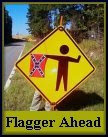SLRC: City should demand resignation of councilman who took Confederate flags
Councilman Arthur L. Dowdell snatched the flags from the graves of several Confederate soldiers in Pine Hill Cemetery last week. The flags had been placed by the local chapter of the United Daughters of the Confederacy in honor of Confederate Memorial Day, an Alabama state holiday.
Dowdell called the flags reminders of racism and, according to one news source, said, “If I had my way I would have broke them all up and stomped on them and burned them.”
In a letter to Auburn Mayor Bill Ham, Jr., SLRC Executive Director Roger McCredie said that the ill-will caused by Dowdell’s actions “has been further exacerbated by [his] arrogant and defiant reaction” to those who have criticized his behavior. “Mr Dowdell has a right to his opinion. He does not have the right to express that opinion through trespass, theft and destruction of property,” McCredie said. He added that “justice and ordinary decency would be served” by the City’s demanding Dowdell’s resignation.
The SLRC, founded in 1995, has been described as “the Southern cultural equivalent of the ACLU.” It is presently involved in a lawsuit against the town of Ringgold, Georgia, which removed a Confederate battle flag from a memorial display at historic Ringgold Depot and replaced it with a different flag.
Below is the text of the SLRC’s letter to the Mayor of Auburn, Alabama.
April 28, 2009
By electronic and U. S. surface mail
Mayor Bill Ham, Jr.
City of Auburn
1846 Hayden Avenue
Auburn, Alabama 36830
RE: Incident at Pine Hill Cemetery
Dear Mayor Ham:
The Southern Legal Resource Center is a federally registered nonprofit organization that advocates in matters involving Southern heritage and culture. As such we have been contacted by several Alabamans who have asked us to investigate Auburn City Councilman Arthur Dowdell’s removal of miniature Confederate flags from the graves of Confederate soldiers at Pine Hill Cemetery.
We have read your published statement and understand that Mr. Dowdell was not acting in any official capacity. However, though he may not have compromised the City of Auburn legally, he has most certainly compromised Auburn’s well-deserved progressive image, as evidenced by the public outcry his vandalism has prompted. This negative public relations situation has been further exacerbated by Mr. Dowdell’s arrogant and defiant reaction to this same outcry. According to at least one news report (www.oanow.com) he stated, “If I had my way, I would have broke them [the flags] all up and stomped on them and burned them “ If Mr. Dowdell is allowed to get away with his lawless behavior and his inflammatory defense of it, the City’s credibility can only suffer more.
Mr. Dowdell has a right to his opinion. He does not have the right to express that opinion through trespass, theft and destruction of property. No doubt the City of Auburn has rules in place governing the public conduct of Council members and surely Mr. Dowdell has violated those rules. Accordingly, we join the Alabamans who have contacted us in suggesting that justice and ordinary decency would be served by the City’s demanding his resignation.
Sincerely yours,
Roger W. McCredie
Executive Director












